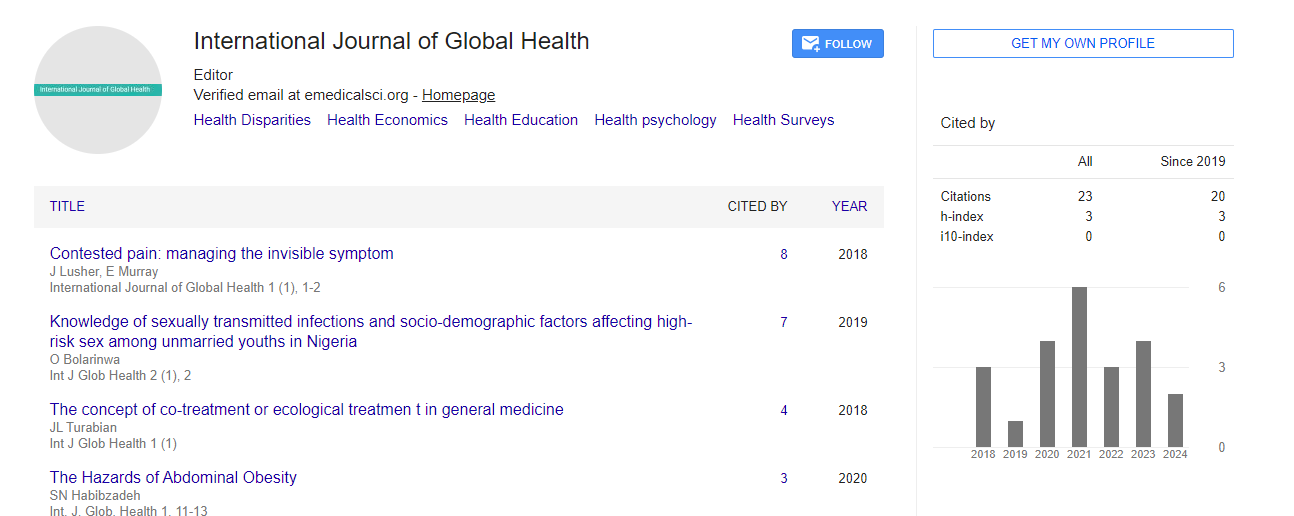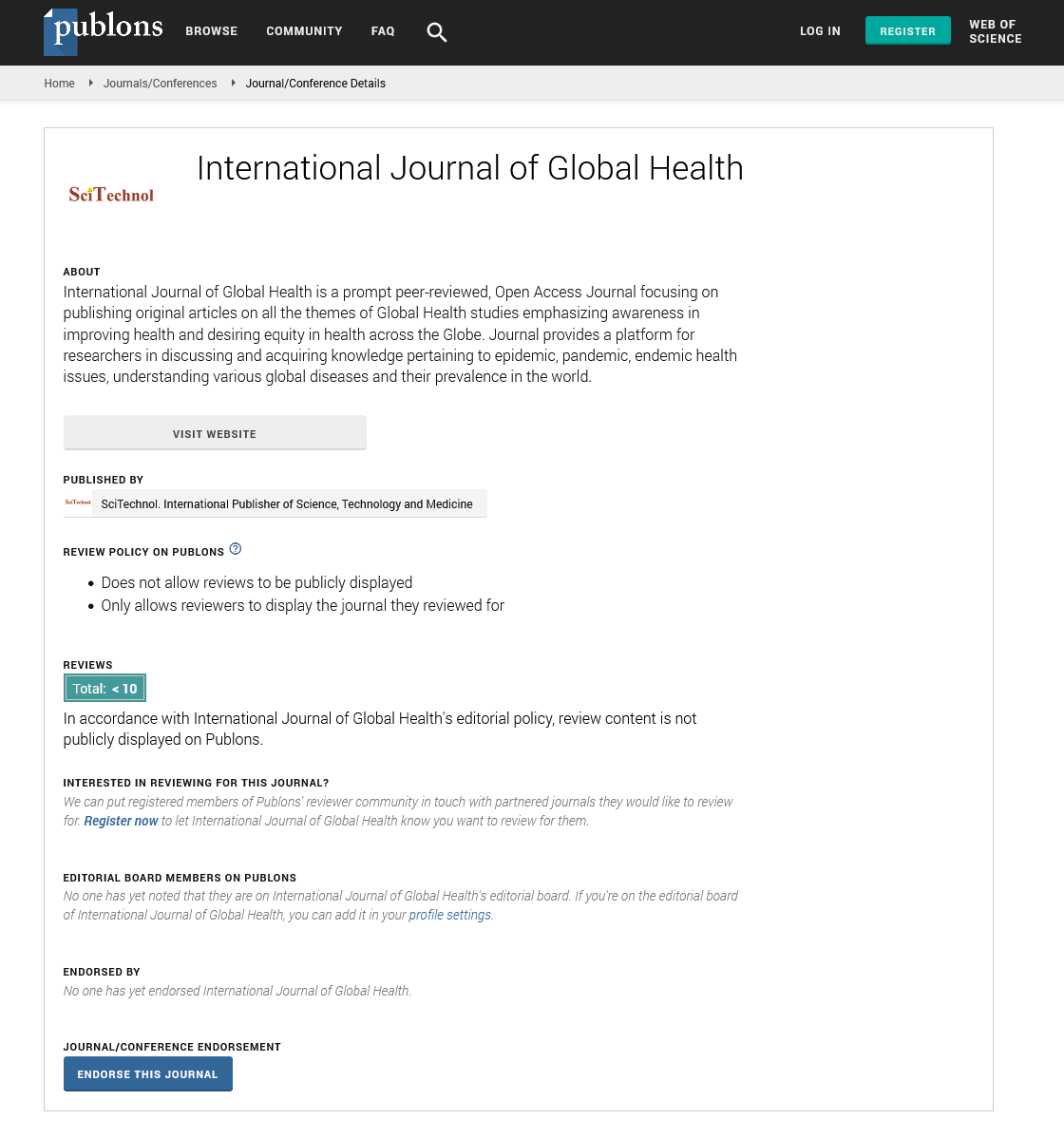Opinion Article, Int J Glob Health Vol: 6 Issue: 2
Well-being in Numbers: Understanding Mortality Rates’ Significance
Haiou Zhang*
1Department of Medicine, Fudan University, Shanghai, China
*Corresponding Author: Haiou Zhang,
Department of Medicine, Fudan University, Shanghai, China
E-mail: hai@ouzh.cn
Received date: 24 May, 2023, Manuscript No. IJGH-23-107361;
Editor assigned date: 26 May, 2023, PreQC No. IJGH-23-107361 (PQ);
Reviewed date: 09 June, 2023, QC No. IJGH-23-107361;
Revised date: 16 June, 2023, Manuscript No. IJGH-23-107361 (R);
Published date: 23 June, 2023 DOI: 10.4172/Ijgh.1000184
Citation: Zhang H (2023) Well-being in Numbers: Understanding Mortality Rates’ Significance. Int J Glob Health 6:2.
Description
Mortality rate is a key indicator used in public health to assess the health and well-being of populations. It provides valuable insights into the occurrence of deaths within a specific population, highlighting trends, patterns, and potential health risks. This study will explore the concept of mortality rate, its significance in public health, and how it is calculated and interpreted.
Mortality rate
Mortality rate, also known as the death rate, measures the number of deaths occurring within a given population over a specific period. It is usually expressed as a rate per 1,000 or 100,000 individuals and is often used as a standardized measure to compare mortality across different populations or time periods. Mortality rates can be calculated for various categories, such as age-specific mortality rates (deaths within specific age groups) or cause-specific mortality rates (deaths attributed to specific causes).
Importance in public health
Mortality rates play an important role in understanding the health status of populations and guiding public health interventions. They provide valuable information about the burden of diseases, identify health disparities, and help monitor the effectiveness of preventive measures and healthcare interventions. By analyzing mortality rates, public health professionals can identify emerging health issues, allocate resources efficiently, and develop evidence-based policies and interventions to improve health outcomes.
Calculating mortality rate
Mortality rate is calculated by dividing the number of deaths within a specific population by the total population and then multiplying the result by a constant (such as 1,000 or 100,000) to express the rate per a standardized population size. The formula is as follows
Mortality rate=(Number of deaths/Total population) × Constant
For example, if a population of 100,000 experiences 1,000 deaths in a year, the mortality rate would be
Mortality rate=(1,000/100,000) × 1,000=10 deaths per 1,000 population
Interpreting mortality rate
Mortality rates provide important insights when interpreted in context. Here are a few key considerations are as follows
Age-specific mortality: Age-specific mortality rates allow for a deeper understanding of mortality patterns within different age groups. Higher mortality rates among older populations may indicate age-related diseases, while higher rates among younger populations may point to issues such as accidents, violence, or infectious diseases.
Cause-specific mortality: Cause-specific mortality rates help identify leading causes of death within a population. This information guides public health priorities and interventions. For example, high rates of cardiovascular disease-related mortality may indicate a need for targeted prevention strategies or improved access to cardiac care.
Comparisons over time: Comparing mortality rates over time can reveal trends and changes in health status. Decreasing mortality rates may indicate improved healthcare access, advancements in medical treatments, or successful prevention efforts. Conversely, increasing rates may suggest emerging health challenges or gaps in healthcare delivery.
International comparisons: Mortality rates also enable comparisons across different countries or regions, highlighting variations in health outcomes and healthcare systems. These comparisons can identify best practices, inform policy decisions, and stimulate global collaboration to improve health worldwide.
Limitations and considerations
While mortality rates provide valuable information, it is essential to consider their limitations
Underlying factors: Mortality rates alone do not provide a complete picture of health. They may not account for underlying social determinants of health, such as education, income, or access to healthcare, which can influence mortality rates. Therefore, a comprehensive analysis of these factors is necessary for a more accurate assessment.
Data quality: Accurate data collection and reporting are necessary for reliable mortality rate calculations. Discrepancies in data collection methods or underreporting of deaths can affect the accuracy of mortality rates. Efforts to improve data quality and consistency are necessary for robust analyses.
Age and population structure: Mortality rates can be influenced by the age and composition of the population under study. Comparisons across populations with different age structures may require age- standardization to account for variations in age distribution.
Conclusion
Mortality rate serves as a vital tool in public health, providing insights into population health, disease burden, and the effectiveness of healthcare interventions. By calculating and interpreting mortality rates, public health professionals can identify health disparities, monitor trends, and guide policy and programmatic decisions. However, it is necessary to consider the limitations and context in which mortality rates are interpreted to ensure a comprehensive understanding of health status and well-being. By utilizing mortality rate data effectively, one can work towards reducing preventable deaths, improving health outcomes, and promoting the well-being of populations worldwide.
 Spanish
Spanish  Chinese
Chinese  Russian
Russian  German
German  French
French  Japanese
Japanese  Portuguese
Portuguese  Hindi
Hindi 
